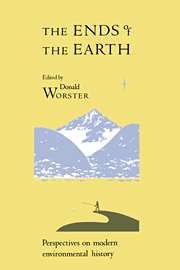Book contents
- Frontmatter
- Contents
- Preface
- INTRODUCTION
- DYNAMICS OF CHANGE
- 2 Environment, Population, and Technology in Primitive Societies
- 3 Climatic Fluctuations and Population Problems in Early Modern History
- 4 The English Industrial Revolution
- THE EUROPEAN INVASION
- CONSERVING NATURE – PAST AND PRESENT
- CONCLUSION
- Appendix: Doing Environmental History
- Bibliography
- Contributors
- Index
4 - The English Industrial Revolution
Published online by Cambridge University Press: 05 June 2012
- Frontmatter
- Contents
- Preface
- INTRODUCTION
- DYNAMICS OF CHANGE
- 2 Environment, Population, and Technology in Primitive Societies
- 3 Climatic Fluctuations and Population Problems in Early Modern History
- 4 The English Industrial Revolution
- THE EUROPEAN INVASION
- CONSERVING NATURE – PAST AND PRESENT
- CONCLUSION
- Appendix: Doing Environmental History
- Bibliography
- Contributors
- Index
Summary
Poverte is hateful good, and, as I gesse, A ful greet bryngere out of bisynesse.
Chaucer, The Wife of Bath's TaleThe ecological roots of the English industrial revolution are not difficult to find. The initial stimulus to change came directly from resource shortages and other ecological effects of an economic system expanding to meet the needs of a population growing within a limited area. As the traditional resources became scarce, new ones were substituted which usually involved more processing, used more productive labour and frequently resulted in what was regarded as an inferior product. As these initial changes made themselves felt in the economic system, the preexisting technical consistency was disturbed and various secondary changes set in motion.
The ecological background to the industrial revolution was an acute land shortage. In the centuries before industrialization the English population was dependent on the land for almost all its materials. The supply of food and drink depended on agricultural land, clothing came from the wool of sheep on English pasture, and large areas of land were needed for extensive forests: Almost all domestic and industrial fuel was firewood, and timber was one of the most important construction materials for houses, ships, mills, farm implements, etc. In addition, the transport system depended on horses and thus required large areas of land to be devoted to grazing and the production of feed. Even lighting used tallow candles, which depended ultimately on the land supply. Land was bound to become in increasingly short supply as population increased.
- Type
- Chapter
- Information
- The Ends of the EarthPerspectives on Modern Environmental History, pp. 80 - 100Publisher: Cambridge University PressPrint publication year: 1989
- 1
- Cited by

